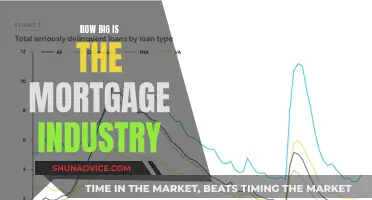
The subprime mortgage crisis of 2007–2010 was a period of financial turmoil caused by the expansion of mortgages to high-risk borrowers, coupled with rising house prices. The crisis led to a crash in home prices and millions of foreclosures. The US central banking system, the Federal Reserve (or the Fed), in partnership with central banks around the world, took several steps to address the crisis. The Fed's response included lowering interest rates, increasing the size of its balance sheet, and conducting open market operations to ensure member banks had access to funds.
What You'll Learn

The Fed's role in the crisis
The subprime mortgage crisis of 2007-2010 was a period of financial turmoil caused by the expansion of mortgages to high-risk borrowers, coupled with rising house prices. The crisis had a severe impact on the US economy, and the Federal Reserve, the country's central banking system, played a crucial role in addressing it.
In the lead-up to the crisis, government-sponsored enterprises, namely Fannie Mae and Freddie Mac, contributed to the expansion of subprime and other risky mortgages. They did this by issuing debt to fund purchases of subprime mortgage-backed securities. However, when house prices peaked, mortgage refinancing and selling homes became challenging, leading to rising mortgage loss rates for lenders and investors.
The Fed's response to the crisis involved several innovative measures to stabilize the financial system and encourage spending. Firstly, they conducted open market operations, providing short-term loans to member banks collateralized by government securities. This improved liquidity and helped banks avoid selling mortgage-backed securities at a loss. The Fed also lowered interest rates, including the Federal funds rate and the discount rate, to stimulate the economy and make borrowing more accessible.
Additionally, the Fed expanded its balance sheet by increasing the amount it was allowed to borrow from the Treasury, funneling money through financial institutions to lend to corporations. They also expanded the types of institutions they lent money to and the collateral they accepted for loans. In March 2008, the Fed increased the monthly amount of auctions to $100 billion and announced term repurchase agreements to enhance financial institutions' ability to sell mortgage-backed debt.
The Fed also provided funds and guarantees to enable bank J.P. Morgan Chase to purchase Bear Stearns, a financial institution with substantial mortgage-backed securities investments that had plunged in value. This prevented a potential fire sale of Bear Stearns' assets, which could have further destabilized the banking system.
Overall, the Fed's role in the subprime mortgage crisis was to promote financial stability, ensure liquidity, and support the economy through various monetary policy tools and interventions.
Mortgage Lenders: A Close Look at Their Practices
You may want to see also

Open market operations
The subprime mortgage crisis of 2007–2010 was caused by the expansion of mortgages to high-risk borrowers, coupled with rising house prices, which contributed to a period of turmoil in financial markets.
The Fed, in partnership with central banks around the world, conducted open market operations to ensure member banks had access to funds (i.e., liquidity). These are effectively short-term loans to member banks collateralized by government securities. Central banks also lowered the interest rates charged to member banks (called the discount rate in the U.S.) for short-term loans. Both measures effectively lubricated the financial system in two key ways.
First, they helped provide access to funds for those entities with illiquid mortgage-backed securities. This helped these entities avoid selling the MBS at a steep loss. Second, the available funds stimulated the commercial paper market and general economic activity. For example, in November 2008, the Fed announced a $600 billion program to purchase the MBS of the GSE, to help lower mortgage rates.
The Fed can electronically create money and use it to lend against the collateral of various types, such as agency mortgage-backed securities or asset-backed commercial paper. The actual and authorized size of the Fed balance sheet (i.e., the amount it is allowed to borrow from the Treasury to lend) was increased significantly during the crisis. The money created was funnelled through certain financial institutions, which used it to lend to corporations issuing the financial instruments that served as collateral.
The type or scope of assets eligible to be collateral for such loans was expanded throughout the crisis. In March 2009, the Federal Open Market Committee (FOMC) decided to increase the size of the Federal Reserve's balance sheet further by purchasing up to an additional $750 billion of government-sponsored agency mortgage-backed securities, bringing its total purchases of these securities to up to $1.25 trillion during 2009, and to increase its purchases of agency debt by up to $100 billion to a total of up to $200 billion.
Prepaying Your Mortgage: How Common Is It?
You may want to see also

Interest rate cuts
The subprime mortgage crisis of 2007-2010 was a period of financial turmoil caused by the expansion of mortgages to high-risk borrowers, coupled with rising house prices. The crisis led to a crash in home prices and millions of foreclosures.
In response to the subprime mortgage crisis, the US central banking system, the Federal Reserve, took several steps, including interest rate cuts. Here is a detailed overview of the Fed's interest rate cuts during the crisis:
The Federal Reserve, or the Fed, played a crucial role in addressing the subprime mortgage crisis by conducting open market operations and providing liquidity to member banks. One of the key measures was lowering interest rates, which helped stabilize the financial system and stimulate the economy.
In August 2007, the Fed signaled the possibility of interest rate cuts as a strategy to mitigate the growing risks to economic growth. Between September 18, 2007, and April 30, 2008, the Fed lowered the target for the Federal funds rate significantly. The rate was reduced from 5.25% to 2% through a series of six separate actions.
Additionally, the discount rate, which is the interest rate charged to commercial banks and other depository institutions on loans from the Fed, was also lowered. The discount rate decreased from 5.75% to 2.25% during the same period, aligning with the reduction in the Federal funds rate.
These interest rate cuts were intended to make borrowing more accessible and affordable, providing relief to borrowers struggling with mortgage payments. By lowering the cost of borrowing, the Fed aimed to stimulate economic activity, encourage lending, and help stabilize the housing market, which was experiencing declining demand and sliding house prices.
The Fed's actions in reducing interest rates were part of a broader set of tools and strategies employed to address the subprime mortgage crisis and promote financial stability. The interest rate cuts, combined with other measures, such as open market operations, the expansion of eligible collateral, and the purchase of mortgage-backed securities, reflected the Fed's efforts to mitigate the impact of the crisis and support the functioning of the financial system.
United Wholesale Mortgage: A Giant in the Industry
You may want to see also

Bailouts
The subprime mortgage crisis of 2007–2010 was a severe economic recession that resulted in millions of job losses and countless bankruptcies. The US government stepped in with a series of measures to stabilise the financial system, including bailouts.
One of the first major bailouts was that of Bear Stearns, which had $210 billion in MBS and other assets that could have caused further devaluation in similar securities across the banking system. The Federal Reserve also bailed out insurance giant AIG with an emergency credit liquidity facility of up to $85 billion in 2008. The Federal Reserve Bank of New York assessed that a disorderly failure of AIG could worsen the financial and economic crisis, and thus intervened.
The US government also passed the Troubled Asset Relief Program (TARP) in 2008, which was a program to purchase toxic assets and equity from financial institutions to strengthen the financial sector. TARP originally authorised expenditures of $700 billion, but this was reduced to $475 billion by the Dodd-Frank Wall Street Reform and Consumer Protection Act in 2010.
Additionally, the Federal Reserve took steps to ensure member banks had access to funds through open market operations, effectively providing short-term loans collateralised by government securities. Central banks also lowered the interest rates charged to member banks, helping to provide access to funds for entities with illiquid mortgage-backed securities.
In March 2009, the Federal Open Market Committee decided to increase the size of the Federal Reserve's balance sheet by purchasing up to an additional $750 billion of government-sponsored agency mortgage-backed securities, bringing its total purchases of these securities to up to $1.25 trillion.
As of January 2018, the US government had recovered all bailout funds, including interest on loans. A total of $626 billion was invested, loaned, or granted, and the Treasury had earned $323 billion in interest, resulting in a profit of $109 billion.
ARM Mortgages: Are They Still Popular?
You may want to see also

The impact on the housing market
The subprime mortgage crisis had a significant impact on the housing market, causing a period of turmoil in financial markets that lasted from 2007 to 2010. The crisis was triggered by a combination of factors, including the expansion of mortgages to high-risk borrowers, rising house prices, and the unregulated creation and trade of derivatives. These factors led to a collapse in the housing market, with home prices falling and many homeowners finding themselves unable to pay their mortgages or sell their homes for a profit.
Before the crisis, real estate made up almost 10% of the economy. When the market collapsed, it had a significant impact on the gross domestic product. As home prices fell, banks lost trust in each other and became afraid to lend to each other, further exacerbating the crisis. The collapse of subprime lending fueled a downward spiral in house prices, undoing much of the increases seen during the subprime boom.
The impact of the crisis on the housing market was also felt through the increase in foreclosures and repossessions, which boosted the number of homes being sold into an already weakened market. Many borrowers tried to sell their homes in "short sales," where the lender accepts limited losses, to avoid foreclosure. This further depressed housing demand and contributed to the downward spiral in house prices.
The crisis also led to a change in lending practices, with lenders making it more difficult for high-risk and even relatively low-risk mortgage applicants to qualify for loans. This further depressed housing demand and made it harder for potential homebuyers to obtain mortgages, particularly those with below-average credit histories or those seeking high-payment loans.
The Federal Reserve and central banks took several steps to address the crisis, including conducting open market operations to ensure member banks had access to funds and lowering interest rates charged to member banks. These measures helped provide liquidity to the financial system and stimulate economic activity. The Fed also increased the size of its balance sheet, funneling money through financial institutions to lend to corporations and expanding the types of collateral it accepts for loans.
Bush's Legacy: Lowering Mortgage Standards, Raising Risks
You may want to see also
Frequently asked questions
The subprime mortgage crisis was a period of turmoil in financial markets that lasted from 2007 to 2010. It was caused by the expansion of mortgages to high-risk borrowers with rising house prices.
There are several factors that contributed to the crisis. One factor was the expansion of mortgage credit to borrowers with below-average credit histories, low down payments, or high-payment loans. Another factor was the repackaging of mortgages into pools that were sold to investors, with private-label mortgage-backed securities (PMBS) providing funding for subprime mortgages.
The Fed took several steps to address the crisis, including conducting open market operations to ensure banks had access to funds and lowering interest rates charged to member banks. They also increased the size of their balance sheet and purchased mortgage-backed securities to help lower mortgage rates.
The Financial Crisis Inquiry Commission, Federal Reserve economists, and academic researchers have stated that government affordable housing policies were not the major cause of the crisis. They argue that Community Reinvestment Act loans outperformed other "subprime" mortgages and that GSE mortgages performed better than private-label securitizations.
The subprime mortgage crisis led to a crash in home prices and millions of foreclosures. It also contributed to the 2008 global financial crisis, which was the worst financial crisis since the Great Depression.







